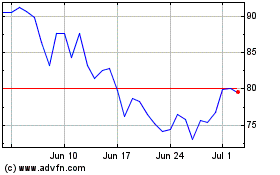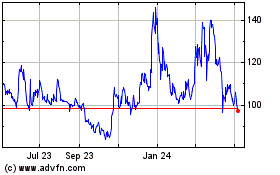The US Fed is Sitting On A $1.2 Trillion Loss On Its Bond Portfolio
15 March 2023 - 4:00AM
NEWSBTC
The United States Federal Reserve (Fed) is sitting on a
$1.2 trillion loss on its $8.3 trillion bond portfolio. Is The FED
Failing? Out of their bond portfolio, the United States central
bank is losing money by paying commercial banks via reverse
repurchase agreements, popularly known as reverse repos or
RRPs. If you thought SVB was bad … The Fed is sitting on
unrealized losses of ~$1.2 trillion on their $8.3 trillion bond
portfolio. And the Fed is losing money every day by paying $$$ to
commercial banks via reverse repos. pic.twitter.com/qBMTq7mR3E —
Wall Street Silver (@WallStreetSilv) March 13, 2023 Reverse repos
are agreements where the central bank, in this case, the
Fed, sells securities, that is, government bonds, to commercial
banks and agrees to repurchase them later at a higher price. This
allows the Fed to inject liquidity into the market, but this has
been coming at a higher cost due to high-interest rates. Related
Reading: USDC Feeling Intense Pressure Despite Fed Action To Halt
SVB Contagion With news showing that the central bank is
hemorrhaging funds after a shift in its monetary policy, there is a
growing concern among investors and financial
experts. The Fed’s bond portfolio is part of its quantitative
easing program following the 2008-2009 global financial crisis. The
idea was for the Fed to buy government and mortgage-backed
securities (MBS) to keep interest rates low and stimulate economic
growth. This worked to some extent, but the downside is that the
Fed is now sitting on many bonds that are losing value on rising
fund rates. Their loss appears worse following the collapse of
banks like Silicon Valley Bank that use customer deposits to buy
government securities. When customers request their money back, the
banks must sell the bonds at a discount, causing losses. To make
depositors of SVB whole, the US government has to step in to
acquire such bonds at face value (reverse repo), which means that
the Fed ends up holding these bonds and their losses. Related
Reading: Bitcoin Bulls Gain Strength, But Is The Fed Really Forced
To Pivot? The situation has raised concerns about the effectiveness
of the Fed’s monetary policy and the impact of government
intervention in the financial markets. Critics have pointed out the
moral hazards behind providing bailouts to failing institutions,
which encourages risky behavior and can lead to a lack of financial
discipline. The founder of hedge fund Citadel, Ken Griffin,
has criticized the government’s decision to bail out
depositors of Silicon Valley Bank, saying it shows that American
capitalism is “breaking down before our eyes.” He believes there
has been a loss of financial discipline and that the government
should not have intervened to protect all depositors, even those
with balances above the federal insurance limit. At the back of
this, Bitcoin prices are rallying, reaching new Q1 2023 highs above
$26,000. Will There Be A Resolution? Some experts argue that the
Fed’s bond portfolio situation is not as dire as it seems. Bonds
are typically held to maturity, which means that unrealized gains
or losses disappear when the bonds are redeemed. Therefore, the
losses only matter if the Fed needs to sell the bonds for
liquidity. Thus, like any bondholder, the Fed is losing to
inflation more than anything else because they have to hold to
maturity. Feature Image From Federal Reserve, Chart From
TradingView
Quant (COIN:QNTUSD)
Historical Stock Chart
From Mar 2024 to Apr 2024

Quant (COIN:QNTUSD)
Historical Stock Chart
From Apr 2023 to Apr 2024
